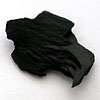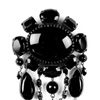- sale
- new items
- lovely beads
- wedding beads
- beads for teens
- for custom order
- newsletter
- recognition
- testimonials
- birthstones
- zodiac signs
- jewelry guide
SHOP BAG
![]() in your bag 0 items
in your bag 0 items
Jet (lignite or gagat) is not considered a true mineral, but rather a mineraloid as it has an organic origin, being derived from decaying wood under extreme pressure. The English noun "jet" derives from the French word for the same material: JAIET. Jet is either black or dark brown, but may contain pyrite inclusions, which are of brassy color and metallic luster. The adjective "jet-black", meaning as dark a black as possible, derives from this material.
Jet is a product of high pressure decomposition of wood from millions of years ago, commonly the wood of trees of the family Araucariaceae. The jet found at Whitby, England is of early Jurassic (Toarcian) age, approximately 182 million years old. Jet is easily polished and is used in manufacturing jewelry, according to the Whitby Museum, dating from 10,000 BC in parts of Germany.
The oldest jet jewelry was found in Asturias, Spain, dating from 17,000 BC. Whitby jet was a favorite material for ornamental jewelry during the Roman period, when it was described by Solinus. Hair-pins, rings, spindles, bracelets, and necklaces were produced in great variety, much of it at Eburacum (modern York).
In the Roman period jet was frequently used as a "magical" material in amulets and pendants because of its supposed protective qualities and ability to deflect the gaze of the evil eye. Furthermore, Pliny the Elder suggests that "the kindling of jet drives off snakes and relieves suffocation of the uterus. Its fumes detect attempts to stimulate a disabling illness or a state of virginity."
Jet as a gemstone was fashionable during the reign of Queen Victoria, during which the Queen wore Whitby jet as part of her mourning dress. Jet was associated with mourning jewelry in the 19th century because of its somber color and modest appearance, and it has been traditionally fashioned into rosaries for monks.
In the United States, long necklaces of jet beads were very popular during the 1920s, or Roaring Twenties, when women and young flappers would wear multiple strands of jet beads stretching from the neckline to the waistline. In these necklaces, the jet was strung using heavy cotton thread; small knots were made on either side of each bead to keep the beads spaced evenly, much in the same way that fine pearl necklaces are made. Jet has also been known as black amber, as it may induce an electric charge like that of amber when rubbed.



